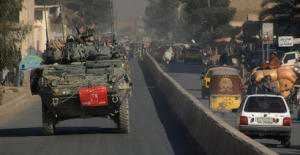
Oromocto, New Brunswick -- The Army will improve or replace its fleets of combat vehicles, providing soldiers with greater protection, mobility and lethality on the battlefield.
Calling it “a great day for the Army,” Lieutenant-General Andrew Leslie announced the $5.2 billion vehicle upgrade and acquisition projects together with federal cabinet ministers July 8 at CFB Gagetown.
The renewal of the fleets will make the Army’s combat vehicles “bigger, harder, faster and better-armed,” the Chief of the Land Staff told about 300 soldiers assembled to hear the announcement.
Noting that every day Canadian troops “risk everything to ensure the security of their fellow Canadians and those they are sent to help,” LGen Leslie said they deserve nothing less than the best level of protection and the most effective equipment the CF can provide.
- The light armoured vehicle (LAV) III Upgrade (LAVUP) project will upgrade 550 vehicles with an option for another 80. The weapons system will be upgraded, additional armour will be installed and the mobility systems such as the power train, suspension, running gear and brakes will be replaced. The upgrade will extend the LAV III life span to 2035.
- The Army will acquire 108 close combat vehicles (CCV) with an option for up to 30 more. The CCV will fill the long-standing gap between the LAV III and the Leopard 2, enabling the infantry to act in close support to the tanks with a well-protected and mobile vehicle that will possess at least the LAV III level of firepower.
- The Army will also acquire a tactical armoured patrol vehicle (TAPV) to replace the Coyote and the RG-31 and provide light infantry battalions with armoured utility vehicles. Two hundred recce vehicles will have a crew of four and either a one-man turret or a remote weapons station (RWS). Three hundred infantry vehicles will serve for command and control and as an armoured personnel carrier (APC), and will have a crew of three, carry four additional soldiers and will be fitted with a RWS. The Army will acquire 500 TAPVs with an option for an additional 100.
- As part of the Force Mobility Enhancement (FME) Project, the Army will buy 13 armoured engineer vehicles (AEV) and two armoured recovery vehicles (ARV), with options for additional vehicles in both cases. These replacements for the Badger will be built on the Leopard 2 chassis and their armour will allow them to operate under heavy fire to clear mines and other obstacles for troops or, in the case of the ARV, to recover tanks and other vehicles.
During the mission in Afghanistan, the Army has been forced to run its combat vehicles very hard on rugged terrain. Taliban insurgents have developed more powerful weapons, especially IEDs, and all NATO armies are seeking ways to upgrade protection for their troops. Defence contractors are focusing heavily on ways to improve the protection of combat vehicles.
The Coyote has served the Army well but more protection is required and the surveillance suites need upgrading to today’s technology. The Army also hopes to improve the interior ergonomics in the TAPV – space is very cramped in the Coyote, especially when soldiers are required to wear all of their kit including ballistic shields. The TAPV will also fill a long-standing requirement for an agile, well-protected vehicle to move light infantry and materiel.
While the projects have been approved, final decisions will not be reached on all specifications for the new vehicles until discussions are completed with potential manufacturers. The Project Director for the CCV, Major Robert Bouchard, said the vehicle will have a high level of off-road mobility and “at least the firepower of a LAV III.” There will be an infantry vehicle and another to serve in a forward observation role. The CCV will have state-of-the-art digital communications suites and other electronics. Weighing in at between 30 and 45 tonnes, it will be deployed to theatre by ship or C-17.
Major Richard Toppa, Project Director for the AEVs and the ARVs, said they represent a “quantum leap forward” in crew protection over the Badger. They will have an increased power pack, improved hydraulics and 2010 or 2011 technology, compared with 1983-84 technology in the Badger. The Army will also acquire dozer blades, mine ploughs and mine rollers.
Initial operational capability for the AEVs and ARVs is scheduled for 2011; for the upgraded LAV IIIs and the CCV 2012; and for the TAPV in 2013.
Number of vehicles:
- LAV III: 550+
- TAPV: 500+
- CCV: 108+
- AEV/ARV: 15+ Total cost: $5.2 billion
Paul Mooney
21.07.2009